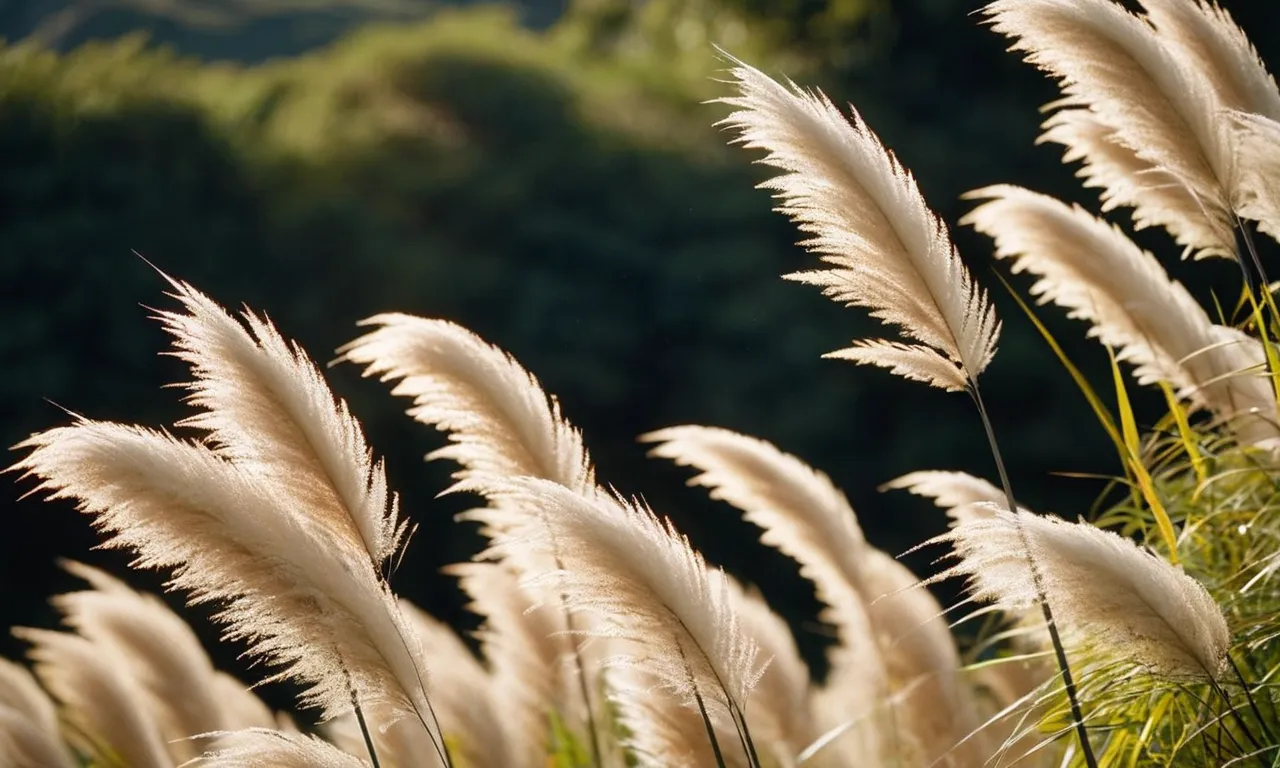Pampas Grass Meaning: A Comprehensive Guide
Pampas grass, with its towering plumes and graceful movements, has become a beloved addition to gardens and landscapes worldwide. But what exactly is the meaning behind this captivating ornamental grass?
If you’re short on time, here’s a quick answer to your question: Pampas grass is a perennial grass native to South America, known for its distinctive feathery blooms and symbolic associations with resilience, strength, and elegance.
In this comprehensive article, we’ll delve into the rich history, symbolism, and cultural significance of pampas grass, as well as explore its various uses and cultivation tips. Whether you’re a gardening enthusiast, a nature lover, or simply curious about this remarkable plant, this guide will provide you with a wealth of information.
Origins and History of Pampas Grass
Native to South America
Pampas grass, with its striking feathery plumes and towering height, is a true South American native. This perennial grass species, scientifically known as Cortaderia selloana, originates from the vast pampas regions of Argentina, Brazil, and Uruguay.
The name “pampas” is derived from the Quechua word “pampa,” meaning “a flat surface or plain,” a fitting description of the vast grasslands where this plant thrives.
According to CABI Invasive Species Compendium, pampas grass is indigenous to the South American countries of Argentina, Brazil, Chile, Paraguay, and Uruguay. It has been an integral part of the local ecosystems and cultural traditions for centuries, thriving in the temperate regions with mild winters and warm summers.
Spread and Cultivation Worldwide
Despite its humble beginnings in South America, pampas grass has since spread its roots across the globe, captivating gardeners and landscapers with its ornamental beauty and hardiness. It was first introduced to Europe in the early 19th century, quickly gaining popularity in gardens and parks.
Today, it can be found in various regions around the world, including:
- North America: Widely cultivated as an ornamental plant in gardens and landscapes across the United States and Canada.
- Europe: Commonly grown in Mediterranean countries, such as Spain, Italy, and Greece, as well as in parts of the UK and other temperate regions.
- Australia and New Zealand: Introduced as an ornamental plant but has become invasive in some areas.
- Asia: Cultivated in regions with suitable climates, like Japan and parts of China.
According to a study by the U.S. National Invasive Species Information Center, pampas grass has been widely distributed through the horticultural trade, contributing to its global spread. While it adds beauty to landscapes, it has also raised concerns about its potential to become invasive in some regions.
Significance in Indigenous Cultures
In its native South American homelands, pampas grass has held great cultural significance for indigenous communities. The Mapuche people of Chile and Argentina have long used the grass for various purposes, including thatching roofs, weaving baskets and mats, and even making musical instruments like pan pipes.
😊
Furthermore, the feathery plumes of pampas grass have been incorporated into traditional ceremonies and rituals, symbolizing strength, resilience, and the enduring spirit of the land. In some regions, the grass is also used for medicinal purposes, highlighting its deep-rooted connection to the local cultures and traditions.
As pampas grass continues to captivate gardeners worldwide, its rich history and cultural significance serve as a reminder of the importance of preserving and celebrating the diverse plant heritage of our planet. 🌍
Symbolism and Meaning of Pampas Grass
Resilience and Strength
Pampas grass is a symbol of resilience and strength, as it thrives in harsh environments and can withstand extreme weather conditions. Native to South America, particularly the Pampas region of Argentina, Brazil, and Uruguay, this hardy plant has adapted to survive in arid climates and nutrient-poor soils.
Its ability to flourish in such challenging conditions is a testament to its tenacity and perseverance. According to Gardening Know How, the pampas grass’s resilient nature has made it a popular ornamental plant in gardens worldwide, symbolizing the human spirit’s ability to overcome adversity.
Elegance and Grace
Despite its rugged nature, pampas grass exudes a sense of elegance and grace that is hard to ignore. Its tall, feathery plumes sway gracefully in the breeze, adding a touch of sophistication to any landscape.
The delicate, silvery-white color of the plumes contrasts beautifully with the deep green foliage, creating a visually stunning display. Pampas grass has long been associated with elegance and refinement, often used in floral arrangements and decorative displays.
Its graceful appearance has made it a favorite among gardeners and designers alike, who appreciate its ability to bring a sense of calm and serenity to any outdoor space. According to Flower Meaning, the pampas grass symbolizes grace, beauty, and sophistication, making it a popular choice for weddings and other formal events.
Fertility and Abundance
In many cultures, pampas grass is revered as a symbol of fertility and abundance. Its ability to produce numerous feathery plumes, each containing thousands of tiny seeds, is seen as a representation of life’s abundance and the cycle of renewal.
The plumes are often used in fertility rituals and ceremonies, as they are believed to bring good luck and prosperity. In some indigenous communities, the pampas grass is considered a sacred plant, with its plumes used in traditional dances and ceremonies to honor the earth’s fertility and abundance.
According to The Spruce, the pampas grass’s association with fertility and abundance stems from its prolific seed production and its ability to thrive in challenging environments, making it a symbol of hope and prosperity.
Beyond its symbolic meanings, pampas grass is also admired for its practical uses. Its sturdy stems and plumes are often used in crafting and basket weaving, while its fibrous leaves can be woven into textiles and rope.
With its multifaceted symbolism and practical applications, it’s no wonder that pampas grass has captured the imagination of people across the globe. Whether used as a decorative element in gardens or as a symbol in cultural traditions, this remarkable plant continues to inspire and captivate those who encounter its beauty and resilience.
Varieties and Characteristics of Pampas Grass
Common Varieties
Pampas grass, scientifically known as Cortaderia selloana, is a striking ornamental grass that comes in several varieties. The most popular and widely cultivated variety is the Pink Pampas Grass, featuring plumes that range from soft pinks to deep purples.
This variety can grow up to 10 feet tall and is a showstopper in any garden! Another common variety is the White Pampas Grass, with fluffy white plumes that add a touch of elegance to landscapes. For those who prefer a more subdued look, the Silvery Pampas Grass boasts silvery-green foliage and creamy-white plumes.
Growth Habits and Features
Pampas grass is a clump-forming perennial grass that can spread up to 6 feet wide. It thrives in full sun and well-drained soil, making it an ideal choice for dry, sunny locations. The sharp-edged leaves can grow up to 6 feet long and are a striking feature of this grass.
According to the Royal Horticultural Society, pampas grass is hardy in USDA zones 7-11, ensuring its success in various climates.
Bloom Characteristics
One of the most captivating aspects of pampas grass is its spectacular blooms. In late summer or early fall, the grass produces towering plumes that can reach up to 12 feet tall! These feathery plumes are a true sight to behold, adding drama and texture to any landscape.
The plumes can last for several months, providing a long-lasting display of beauty. 😍 Interestingly, the plumes are often used in floral arrangements and dried decorations, making them a versatile and sought-after addition to any garden.
Whether you’re looking to add height, texture, or a touch of whimsy to your outdoor space, pampas grass is an excellent choice. With its striking appearance and relatively low maintenance requirements, it’s no wonder this grass has become a favorite among gardeners and landscape designers alike.
So why not consider adding a touch of pampas grass magic to your garden? 🌾🌿
Uses of Pampas Grass
Ornamental Landscaping
Pampas grass is a popular choice for ornamental landscaping due to its striking appearance and versatility. Its tall, feathery plumes can add texture and drama to any garden or landscape design. Gardeners often use pampas grass as a focal point or to create natural screens and borders.
Its unique form and size make it a stunning addition to gardens, parks, and public spaces. According to The Spruce, pampas grass can grow up to 10 feet tall, making it an impressive sight in any outdoor setting.
Dried Floral Arrangements
The fluffy plumes of pampas grass are highly sought after for dried floral arrangements. Their unique texture and natural beauty make them a popular choice for creating stunning bouquets, wreaths, and centerpieces.
The dried plumes can last for years, making them a sustainable and long-lasting option for home decor. Many florists and craft enthusiasts incorporate pampas grass into their creations, adding a touch of elegance and whimsy.
According to Garden Design, pampas grass has been a staple in dried floral arrangements for decades, and its popularity continues to grow.
Biofuel and Construction Materials
Beyond its ornamental uses, pampas grass has practical applications in the biofuel and construction industries. The fibrous stems of the plant can be used as a source of biomass for biofuel production, offering a renewable and sustainable alternative to fossil fuels.
In some regions, pampas grass is cultivated specifically for this purpose, contributing to the development of clean energy solutions. Additionally, the strong and durable nature of pampas grass makes it a suitable material for thatching roofs and constructing shelters in rural areas.
Its availability and affordability make it an accessible resource for communities in need of sustainable building materials.
Whether used for landscaping, floral arrangements, or practical applications, pampas grass is a versatile and captivating plant that continues to find new uses and appreciation around the world. Its unique beauty and functional properties make it a valuable asset in various industries and settings.
As environmental consciousness grows, the sustainable and renewable nature of pampas grass further contributes to its appeal and potential for future applications.
Cultivating and Caring for Pampas Grass
Planting and Growing Conditions
Pampas grass (Cortaderia selloana) is a hardy and striking ornamental grass that can add texture and drama to any landscape. To cultivate this South American native, it’s essential to provide the right growing conditions.
Pampas grass thrives in full sun, requiring at least six hours of direct sunlight each day. It prefers well-draining soil, whether sandy, loamy, or clay-based, but avoid overly wet or waterlogged areas.
According to the Missouri Botanical Garden, pampas grass is hardy in USDA Zones 7-10, making it a suitable choice for warm and temperate climates.
Maintenance and Pruning
Proper maintenance is key to keeping your pampas grass looking its best. In early spring, prune away the previous year’s dead foliage by cutting it back to the ground. This encourages new growth and prevents the plant from becoming overgrown and unsightly.
During the growing season, you can remove any dead or damaged leaves as needed. Pampas grass is relatively drought-tolerant once established, but regular watering during dry spells will keep it looking lush and green.
Consider applying a balanced fertilizer in early spring to promote vigorous growth and abundant plumes.
Did you know? Pampas grass can grow up to 10 feet tall and 6 feet wide, making it a stunning focal point in any garden!
Potential Invasiveness and Control Measures
While pampas grass is a beautiful and low-maintenance addition to many landscapes, it’s important to be aware of its potential to become invasive in certain regions. The plant is considered an invasive weed in parts of California, Hawaii, and other areas with mild climates.
Its prolific seed production and ability to spread quickly can pose a threat to native ecosystems. To control the spread of pampas grass, it’s crucial to remove the feathery plumes before they release their seeds.
Some states, like California, have even banned the sale and cultivation of certain varieties due to their invasive nature. If you live in an area where pampas grass is known to be invasive, consider alternative ornamental grasses or consult local authorities for guidance on responsible cultivation and control measures.
By being mindful of its potential impact, we can enjoy the beauty of pampas grass while protecting our natural environments.
Conclusion
Pampas grass, with its rich history, symbolic meanings, and diverse uses, has truly earned its place as a beloved ornamental plant. From its resilient nature and elegant plumes to its cultural significance and practical applications, this remarkable grass continues to captivate gardeners and nature enthusiasts alike.
Whether you’re seeking to add a touch of drama to your landscape, create stunning dried floral arrangements, or simply appreciate the beauty and symbolism of this plant, understanding the meaning of pampas grass can enhance your appreciation for its presence in our gardens and natural environments.
As you embark on your journey of cultivating or simply admiring pampas grass, remember to embrace its resilience, celebrate its elegance, and honor its cultural significance. With proper care and respect for its potential invasiveness, this remarkable grass can continue to grace our landscapes for generations to come.








